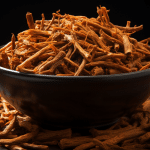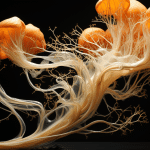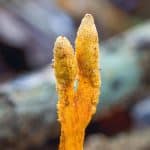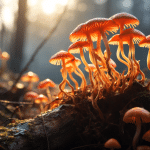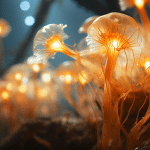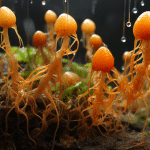Cordyceps militaris, a fungus of intrigue and traditional importance, thrives in specific environments that foster its unique growth requirements. This organism has garnered attention for its potential health benefits, leading many to wonder about its natural habitat. Understanding where does cordyceps militaris grow involves exploring various geographical locations and climatic conditions conducive to its development. The journey into the world of Cordyceps militaris not only enlightens us about this fascinating fungus but also emphasizes the delicate balance of ecosystems it inhabits.
Natural Habitats of Cordyceps Militaris
Cordyceps militaris, a unique fungus, thrives in specific environments. It prefers humid and cool conditions. These are often found in Asian countries like China, Nepal, Bhutan, Korea, and Thailand. The fungus grows at high altitudes ranging from 3,000 to 5,000 meters above sea level.
This organism has a fascinating life cycle. It infects insects and arthropods. Once infected, the host becomes a nutrient source for the growing fungus. Over time, cordyceps militaris emerge from the host’s body. Key locations:
The habitat of cordyceps militaris is not limited to Asia alone. Researchers have discovered its presence in North American forests as well. However, it’s less common there compared to its abundance in Asian mountains. Understanding where does cordyceps militaris grow helps scientists study its properties better. This knowledge also aids in sustainable harvesting practices that protect natural populations.
Geographical Distribution of Where Does Cordyceps Militaris Grow
Cordyceps militaris, a unique fungus with remarkable benefits, thrives in diverse regions across the globe. Its presence is not limited to a single climate or continent. Instead, it spans various geographical locations with distinct environmental conditions. This fungus predominantly grows in Asia, notably in China, Nepal, Bhutan, Korea, and Thailand. These areas offer the ideal combination of humidity and temperature that cordyceps militaris require for growth. In these countries, locals have harvested it for centuries due to its medicinal properties.
Apart from Asia, this fungus also makes appearances in North America and Europe. However, its distribution here is less dense compared to Asian countries. The environments where wild cordyceps militaris can be found range from high mountainous regions to lush forests where caterpillars serve as hosts for their growth. The adaptability of cordyceps militaris allows it to flourish under specific conditions rather than being confined by geographic boundaries. It prefers elevations above 3,500 meters, where temperatures are cooler and more consistent throughout the year.
Understanding the geographical distribution of wild cordyceps militaris highlights its global significance and potential availability outside traditional Asian markets. This information could pave the way for increased cultivation efforts worldwide to meet growing demand while preserving natural habitats.
Overview of Cordyceps Militaris Cultivation Techniques
Cultivating Cordyceps militaris has become a viable alternative to wild harvesting. This is due to the increasing demand for its medicinal properties. The cultivation process involves specific techniques that ensure the growth and potency of the fungus.
To start, selecting a suitable substrate is crucial. Common substrates include rice, millet, or silkworm pupae. These provide the necessary nutrients for Cordyceps militaris to thrive. The substrate must be sterilized to prevent contamination from other fungi or bacteria. Temperature and humidity control are next in line for importance. Cordyceps militaris requires a temperature range between 20°C and 25°C during its growth phase. Humidity levels should be maintained at 60% to 80%. These conditions mimic its natural habitat found in high-altitude regions discussed previously.
Lighting also plays a role in cultivation but differs from most plants’ needs. Cordyceps militaris grows best under low light conditions or even darkness during certain stages of its lifecycle. Key steps in cultivating Cordyceps militaris:
-
Selection of an appropriate substrate;
-
Sterilization of the substrate;
-
Maintenance of optimum temperature and humidity;
-
Control of lighting conditions according to growth stage.
Monitoring for contamination is continuous throughout cultivation since any presence can compromise yield quality.
Preparing Nutrient Broth for Cordyceps Growth
Creating a nutrient broth is crucial for cultivating Cordyceps Militaris. This broth provides the essential nutrients needed for the fungi to grow. It’s made by combining water with various nutrients, including sugars, amino acids, and minerals. To start, you need clean water as your base. Distilled or purified water works best because it doesn’t contain contaminants that might harm the fungi. Then, add organic brown rice or soybeans, as they are excellent sources of carbohydrates and proteins, which are vital for growth.
Next, incorporate yeast extract into your mixture. Yeast extract is rich in B vitamins and other nutrients that support fungal development. Some cultivators also add small amounts of peptone or malt extract to boost nutrient content further. After mixing these ingredients, sterilize the broth by autoclaving at 121 degrees Celsius for 15 minutes. Sterilization kills any unwanted bacteria or microorganisms that could compete with Cordyceps Militaris.
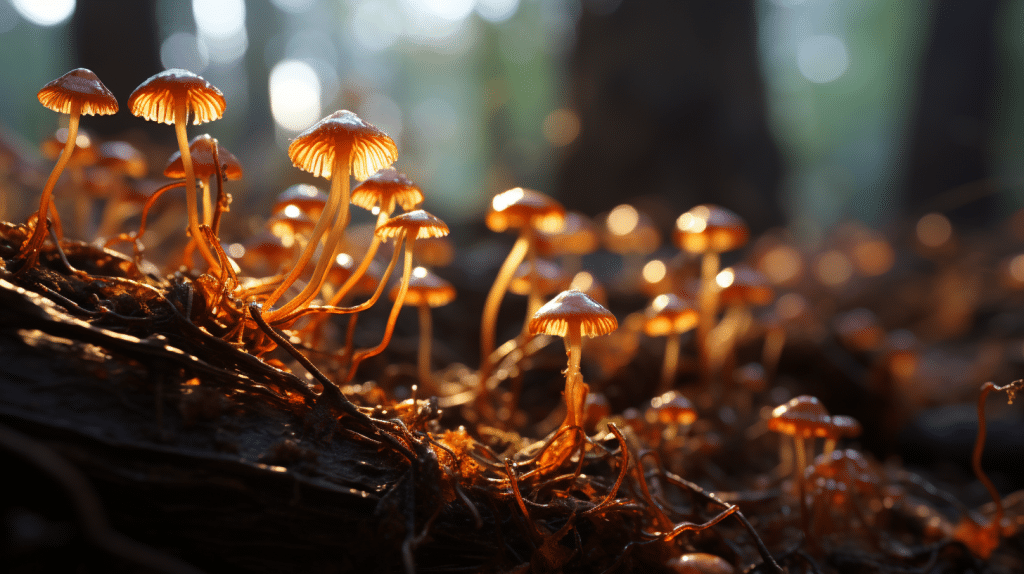
Harvesting and Analyzing Cordyceps Militaris
After the inoculation and incubation phases, attention shifts to harvesting. This stage is crucial for ensuring the quality of Cordyceps Militaris. The fungus typically grows in specific conditions, thriving in high humidity and moderate temperatures. It prefers environments that mimic its natural habitat found in Asian mountains. Harvesting occurs when the fruiting bodies are mature. This maturity is often indicated by a change in the colour and size of the fungi. Careful handling during this process prevents damage, maintaining their value and potency.
Once harvested, analysis ensures their quality before they reach consumers or researchers. Laboratories test for active compounds such as cordycepin, which defines their medicinal value. Key steps include:
-
Observing physical changes signalling maturity;
-
Gentle detachment from growth mediums;
-
Immediate storage under controlled conditions to prevent degradation.
The analysis also involves checking for contaminants that could have been introduced during earlier stages of cultivation or harvesting. Understanding where does cordyceps militaris grow naturally aids researchers in replicating these conditions artificially for mass production. This knowledge translates into effective cultivation strategies discussed previously regarding inoculation and incubation methods.
Optimization Techniques for Higher Cordycepin Yield
Optimizing the growth conditions of Cordyceps militaris is crucial for maximizing cordycepin yield. Several techniques can be applied to achieve this goal. Firstly, controlling the temperature and humidity within the growing environment plays a significant role. Ideal temperatures range from 20°C to 25°C, with relative humidity levels between 60% and 80%. These conditions mimic the natural habitat of Cordyceps militaris, promoting optimal growth.
Secondly, adjusting light exposure influences cordycepin production significantly. While Cordyceps militaris requires periods of darkness to initiate its lifecycle, introducing cycles of blue or ultraviolet light has been shown to boost cordycepin content. Implementing a lighting schedule that alternates between 12 hours of light and 12 hours of darkness can lead to higher yields.
farmers and researchers can significantly enhance the production of high-quality Cordyceps militaris with elevated levels of cordycepins. This not only improves efficiency but also increases profitability in commercial operations focused on health supplement markets where demand for natural products continues to rise.
Challenges in Cordyceps Militaris Cultivation
Cultivating Cordyceps militaris presents unique challenges. These fungi require specific conditions to thrive. Temperature, humidity, and substrate are crucial factors. The ideal temperature for growth is between 20°C and 25°C. Humidity levels must stay high, around 90% to 95%. Substrates like rice or grain provide the nutrients needed.
Contamination poses a significant threat to cultivation efforts. Bacteria and other fungi can easily invade cultures if not properly managed. This requires strict sterilization procedures of equipment and growing spaces. Another challenge is reproducing natural growth conditions in an artificial environment. In the wild, Cordyceps militaris grows on insects. Mimicking this environment means finding suitable substitutes that provide similar nutritional profiles without attracting pests or diseases.
To conclude, successfully growing Cordyceps militaris demands attention to detail and adherence to best practices in fungal agriculture. Despite advancements in optimization techniques for higher cordycepin yield, challenges such as contamination control, environmental condition replication, and maintaining high-quality substrates persistently test cultivators’ skills and resources.
What does Cordyceps Militaris grow on?
Where does cordyceps militaris grow? Cordyceps Militaris is a parasitic fungus that typically grows on the larvae of ghost moths and other insects. The fungus enters the body of the host through the mouth or spiracles and then begins to grow and consume the host from the inside out. The mature fungus eventually erupts from the body of the host, killing it in the process.
It’s hailed in China as a cultural icon due to its use throughout history as well as for its prominence and prestige throughout the world. More people are trying to figure out the best ways to cultivate Cordyceps Militaris at scale to meet the demand for this potent functional mushroom. The most common host for cordyceps is the caterpillar of the ghost moth. The fungus attacks the caterpillar while it is still alive and then continues to grow inside of it, eventually killing it. Once the caterpillar is dead, the cordyceps fungus will sprout from its head and release spores into the air in order to infect other caterpillars.
You must first create a nutrient broth for both jars and in cultivation. The nutrient broth is used to moisten your brown rice, or “matrix,” which supports the mushroom mycelium’s growth. Brown rice and broth will grow Cordyceps. Ingredients for nutrient broth:
- 10 grams multivitamins (crushed)
- 19 grams of nutritional yeast or soy peptone
- 11 grams of kelp powder
- 3.5 grams gypsum
- 1-gallon coconut water
- 10 grams tapioca starch
- 5 grams of magnesium sulfate
Combine dry ingredients: In a mixing basin, combine nutritional yeast or soy peptone, tapioca starch, magnesium sulfate, kelp powder, crushed nutrients, and gypsum. Then add coconut water and mix well. The broth can be kept for up to a week in the fridge.
Below is a video from our friends at North Spore that outlines the process in more detail:
You can find our favourite capsules, powders, and tinctures on the following pages of our website and learn more about each individually:
Click here to view our List of The Best Cordyceps Supplement
Click here to view our List of The Best Cordyceps Powder
Click here to view our List of The Best Cordyceps Tincture
Click here to view our List of The Best Cordyceps Mushroom Gummies
Additional Resources:
What type of mushroom is cordyceps?
What are the benefits of cordyceps mushroom?
Updated 10/18/2022







